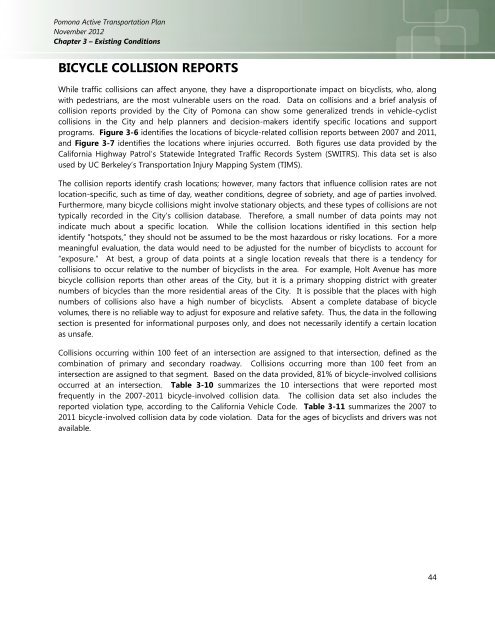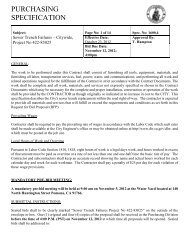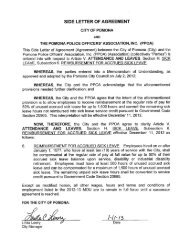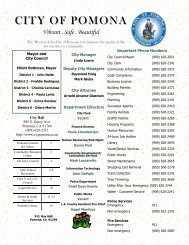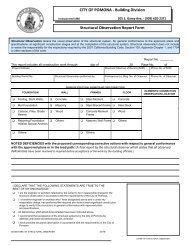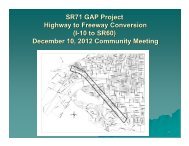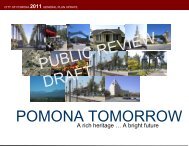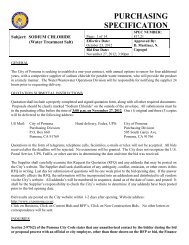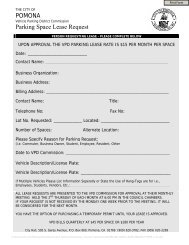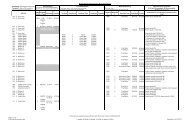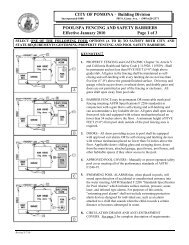Active Transportation Plan - City of Pomona
Active Transportation Plan - City of Pomona
Active Transportation Plan - City of Pomona
You also want an ePaper? Increase the reach of your titles
YUMPU automatically turns print PDFs into web optimized ePapers that Google loves.
<strong>Pomona</strong> <strong>Active</strong> <strong>Transportation</strong> <strong>Plan</strong><br />
November 2012<br />
Chapter 3 – Existing Conditions<br />
BICYCLE COLLISION REPORTS<br />
While traffic collisions can affect anyone, they have a disproportionate impact on bicyclists, who, along<br />
with pedestrians, are the most vulnerable users on the road. Data on collisions and a brief analysis <strong>of</strong><br />
collision reports provided by the <strong>City</strong> <strong>of</strong> <strong>Pomona</strong> can show some generalized trends in vehicle-cyclist<br />
collisions in the <strong>City</strong> and help planners and decision-makers identify specific locations and support<br />
programs. Figure 3-6 identifies the locations <strong>of</strong> bicycle-related collision reports between 2007 and 2011,<br />
and Figure 3-7 identifies the locations where injuries occurred. Both figures use data provided by the<br />
California Highway Patrol’s Statewide Integrated Traffic Records System (SWITRS). This data set is also<br />
used by UC Berkeley’s <strong>Transportation</strong> Injury Mapping System (TIMS).<br />
The collision reports identify crash locations; however, many factors that influence collision rates are not<br />
location-specific, such as time <strong>of</strong> day, weather conditions, degree <strong>of</strong> sobriety, and age <strong>of</strong> parties involved.<br />
Furthermore, many bicycle collisions might involve stationary objects, and these types <strong>of</strong> collisions are not<br />
typically recorded in the <strong>City</strong>’s collision database. Therefore, a small number <strong>of</strong> data points may not<br />
indicate much about a specific location. While the collision locations identified in this section help<br />
identify “hotspots,” they should not be assumed to be the most hazardous or risky locations. For a more<br />
meaningful evaluation, the data would need to be adjusted for the number <strong>of</strong> bicyclists to account for<br />
“exposure.” At best, a group <strong>of</strong> data points at a single location reveals that there is a tendency for<br />
collisions to occur relative to the number <strong>of</strong> bicyclists in the area. For example, Holt Avenue has more<br />
bicycle collision reports than other areas <strong>of</strong> the <strong>City</strong>, but it is a primary shopping district with greater<br />
numbers <strong>of</strong> bicycles than the more residential areas <strong>of</strong> the <strong>City</strong>. It is possible that the places with high<br />
numbers <strong>of</strong> collisions also have a high number <strong>of</strong> bicyclists. Absent a complete database <strong>of</strong> bicycle<br />
volumes, there is no reliable way to adjust for exposure and relative safety. Thus, the data in the following<br />
section is presented for informational purposes only, and does not necessarily identify a certain location<br />
as unsafe.<br />
Collisions occurring within 100 feet <strong>of</strong> an intersection are assigned to that intersection, defined as the<br />
combination <strong>of</strong> primary and secondary roadway. Collisions occurring more than 100 feet from an<br />
intersection are assigned to that segment. Based on the data provided, 81% <strong>of</strong> bicycle-involved collisions<br />
occurred at an intersection. Table 3-10 summarizes the 10 intersections that were reported most<br />
frequently in the 2007-2011 bicycle-involved collision data. The collision data set also includes the<br />
reported violation type, according to the California Vehicle Code. Table 3-11 summarizes the 2007 to<br />
2011 bicycle-involved collision data by code violation. Data for the ages <strong>of</strong> bicyclists and drivers was not<br />
available.<br />
44


